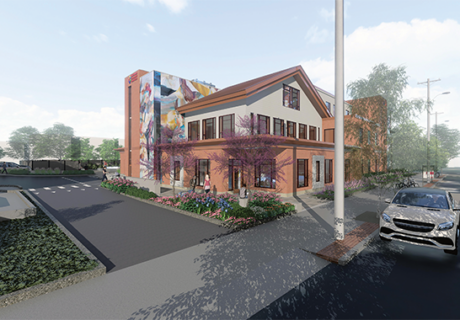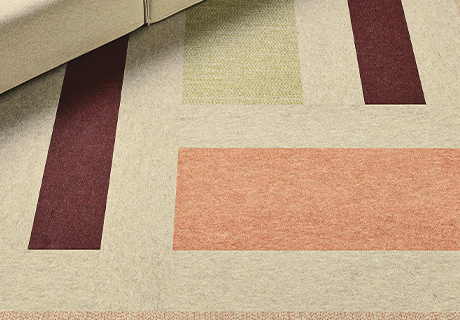SPONSORED
The Art of Healing: How Interior Designers Can Impact Healthcare Environments Through Visuals
There’s a reason healthcare designers are (and will always be) in demand: Studies show that their expertise can improve the lives of those who could use all the good vibes they can get.
That’s why designers and architects are consistently drawn to the Master of Professional Studies in Design of Healthcare Environments (MPSH) degree program at the New York School of Interior Design (NYSID). In just one year of coursework, not only do students learn how interior design as a whole can impact healthcare spaces, but they also dive deep into specific elements of design that are much more strategic than people might think.
One of those elements? Art.
“Art plays a significant role in the healing process of patients, serving as a positive distraction in waiting areas and examination rooms, and during long stays,” says Antonio Rodriguez‑Arguelles. A NYSID MFA2 graduate who has since taught several courses in the MPSH program, Antonio is currently an associate and senior interior designer for EwingCole in New York, where he collaborates with prestigious city institutions such as Northwell Health and NYU Langone Health.
In other words, he’s a healthcare design guru. And if you’re at all considering specializing in this area too, learn more about the role art plays in healthcare design through this Q&A with Antonio.

Proposal for a LDR renovation, confidential client – A growing preference for abstract art featuring bold colors and shapes that complement closely the finish palette is one the latest trends in art integration within healthcare interior design. Renderings by Antonio Rodríguez – EwingCole.
Q: How does art contribute to the healing process in healthcare environments?
Antonio: Art contributes to the creation of uplifting environments that enhance our state of mind and alleviate stress associated with healthcare environments.
In the research paper A Guide to Evidence-based Art, authors Kathy Hathorn, MA, and Upali Nanda, PhD, cite studies on how “evidence from heart-rate recordings and questionnaires showed that stress in a dental clinic was appreciably lower on days when a large mural was hung at the back of a waiting room (Heerwagen, 1990).” And how in another one, “images of serene nature scenes mounted to the ceiling were shown to highly stressed pre-surgical patients on gurneys; this resulted in lower blood pressure (Coss, 1990).”
Moreover, art is a powerful tool for improving wayfinding, complementing other architectural designs and signage features throughout interior spaces. Art can create “landmarks” that often can foster a palpable connection to the community while reinforcing inclusivity by considering the ethnic, gender, and age diversity of patients and caregivers.

Proposal for a Respite and Lactation Room, confidential client – Along soft seating, dimmable lighting, and materials to improve acoustics, art completes the design of this staff-only space, providing positive distraction with added color and pattern. Rendering by Antonio Rodríguez – EwingCole.
Q: What are the key principles to consider when integrating art into healthcare interior design?
A: When integrating art into healthcare design, it’s crucial to ensure it isn’t an afterthought but rather a celebrated focal point in every space. As interior designers, we shape spaces using color, texture, and materiality, carving and preparing them to accommodate art successfully. Practical considerations can include clearing walls of unwanted devices, as well as coordinating lighting and wall-blocking requirements carefully.
Sometimes, it all starts with the way we show art in our renderings; strategizing from early in the design process what walls or surfaces will be “completed” when they receive a piece of art is as important as any other interior decision during the review process with our clients.
Selection can pose challenges, but in my experience, our art consultants, and institutional partners, who often manage art collections or arts programs in-house, help address them, generally selecting art that communicates their institutional mission and larger goals.
Q: We’ve established that art can affect patients. Who else, and what else?
A: Great art has the power to deeply move us, especially in times of vulnerability. Whether one is a companion or caregiver of a patient, or an overextended staff member, both roles can be significant stressors. The well-being of these individuals is directly tied to that of the patient, enhancing their path to recovery at every step of the way.
For staff members, placing art in respite rooms with comforting amenities can be beneficial. This can include calm waterscapes or figurative art that is diverse and provides positive distraction, along with soft seating, sound-absorbing materials that enhance acoustics, and dimmable lighting.
I have observed instances where staff members create and display their art at their clinical workplace. This involvement can further engage them in the healing process, while also fostering appreciation from their employers and admiration from their colleagues.

The Brooklyn Hospital Center, Physician Pavilion — Clusters of lighting sconces arranged in artful compositions can add much-needed visual interest to public and clinical areas alike when an art program or budget isn’t in place yet. Rendering by Antonio Rodríguez – EwingCole.
Q: How do you select appropriate art for different types of healthcare spaces (e.g., pediatric wards vs. adult care units)?
A: The age diversity of patients and caregivers will always significantly influence our design approach. Pediatric units often incorporate cheerful and engaging imagery to create a warm and inviting environment. These elements can also stimulate different senses and encourage physical interaction, enhancing the overall experience for toddlers, teenagers, and young adults alike.
In contrast, adult care units typically prioritize a sense of calm and peacefulness. Designs often guide patients and visitors through a curated journey, diverting their focus from current circumstances towards hopeful future experiences and outcomes.
Q: What are the latest trends in art integration within healthcare interior design?
A: Recently, I’ve noticed a decline in the use of landscapes or images of nature in healthcare environments, with a growing preference for abstract art featuring bold colors and shapes that can complement furnishings and finish palettes more closely. Additionally, there’s an increased interest in figurative art that promotes diversity and reflects the context and community surrounding the medical facility.
Another emerging trend is the integration of decorative elements such as mirrors and picture lights around art pieces. This helps to create a less institutional atmosphere, making healthcare environments feel more like home.
Furthermore, there is a significant movement towards specifying bold, mural-like wallcoverings. These wallcoverings are not only easy to clean and high-performing but also serve a dual purpose as art, adding much-needed visual interest to the space when an art program is not in place, or there are budget constraints to purchase higher-end pieces properly framed and installed.
Q: Can you share a personal experience where you felt particularly proud of the art integration in a healthcare project?
A: I recently completed a confidential center for advanced imaging in a New York City hospital basement, where low ceilings and lack of daylight presented obvious design challenges. To counter this, we maintained a light and airy architectural material palette, adding saturated accents through upholsteries and colorful art pieces provided by our institutional art partner.
Early in the project, we designed a reception desk with a shelf intended to host a sculpture. However, as the project progressed, we had to accommodate additional IT requirements, including self-check-in tablets for patients. We had to pivot and reorganize the space, placing a large canvas above the tablets in lieu of the sculpture. This helped balance compositionally the weight of the desk itself, and created a visual landmark, aiding wayfinding at this important patient touchpoint.
As a designer, it’s fulfilling to see how our process evolves and sometimes diverges from our initial sketches, resulting in something unexpected yet successful. Art placement, often one of the final layers of the interior design, can be a pleasant surprise, completing the overall picture in ways not foreseen.
Q: What advice would you give to architects and designers new to this field?
A: My advice is to strive for innovative healthcare solutions that are unexpected and stand on their own as great interior design. Approach your work with empathy, recognizing that design is inherently intentional and can drive positive change, benefiting patients, families, friends, and staff members alike.
The MPSH program at NYSID is excellent for architects and designers seeking to excel in this field. It provides the tools to distinguish oneself in the job market and in facilitating the creation of healthcare spaces that embrace a holistic, interdisciplinary approach.
Intrigued? Get more information on the New York School of Interior Design’s MPSH program.




